With the last of the boats I´ve visited for you during the 2025 edition of Cannes Yachting Festival I want to present a very special yacht. She is not a new boat as the first Pegasus 50 has already been launched back in 2021. But since I´ve seen the first pictures and drawings of that boat I was eager to see one. As you can imagine, it is not a high-volume producer so the chance of getting a foot on one boat “in the wild” is miniscule, more so because of the fact that she is meant to be a passage maker, not a coastal cruiser.
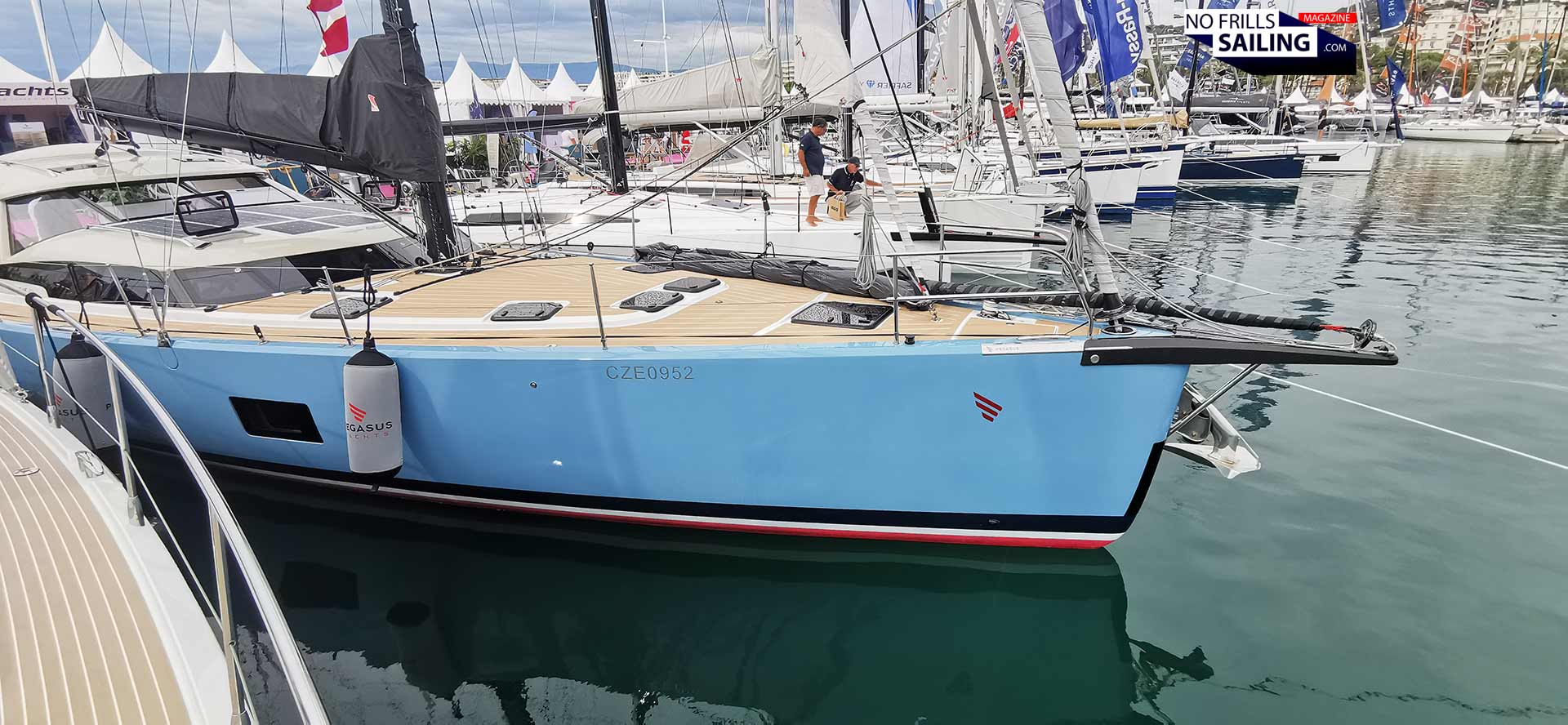
And so I was very happy to see this yacht exhibited at the Croisette and being invited aboard by the shipyard crew with a warm welcome. The story of the Pegasus reminded me a bit of the Kraken Yachts or other smaller start-ups, founded by people with a long career in yacht design and boatbuilding, now coming up with an own shot at what should be the perfect boat from their perspective. Pegasus Yachts had been founded by Miha Breskvar and Marko Pas in 2019 after years and years in boatbuilding, for example with J&J. The two are most famous for their involvement with Shipman Yachts, notably the first series-built Carbon boats.
A very unique design
The Pegasus 50 has been designed by both guys and you can clearly see echoes from the Shipman-designs as well as from other beloved long haul and luxury brands. But the Pegasus 50 found her own design language, in fact, Marko and Miha managed to come up with a very beautiful and seamlessly integrated hardtop/bimini solution for the yacht: Something that other, sometimes even bigger and more renowned brands tremendously failed at. A Pegasus 50 cannot be mistaken or confused with another boat. She truly speaks her very own design language.

One of these, let´s say “signature” design choices is for example the alignment of the skylight hatches on deck. If you look closely onto the picture above, you´ll notice that the hatches follow the line of the coachroof, not the line of the hull. This is only a subtle, yet very defining choice that sets a tone. Also, the wheelhouse or raised salon of the yacht with the very dark tinted windows gives it a unique look. All in all she incorporates quite modern and “bold” lines with a very classic or conservative approach in other places, which makes her fun and exciting to look at.
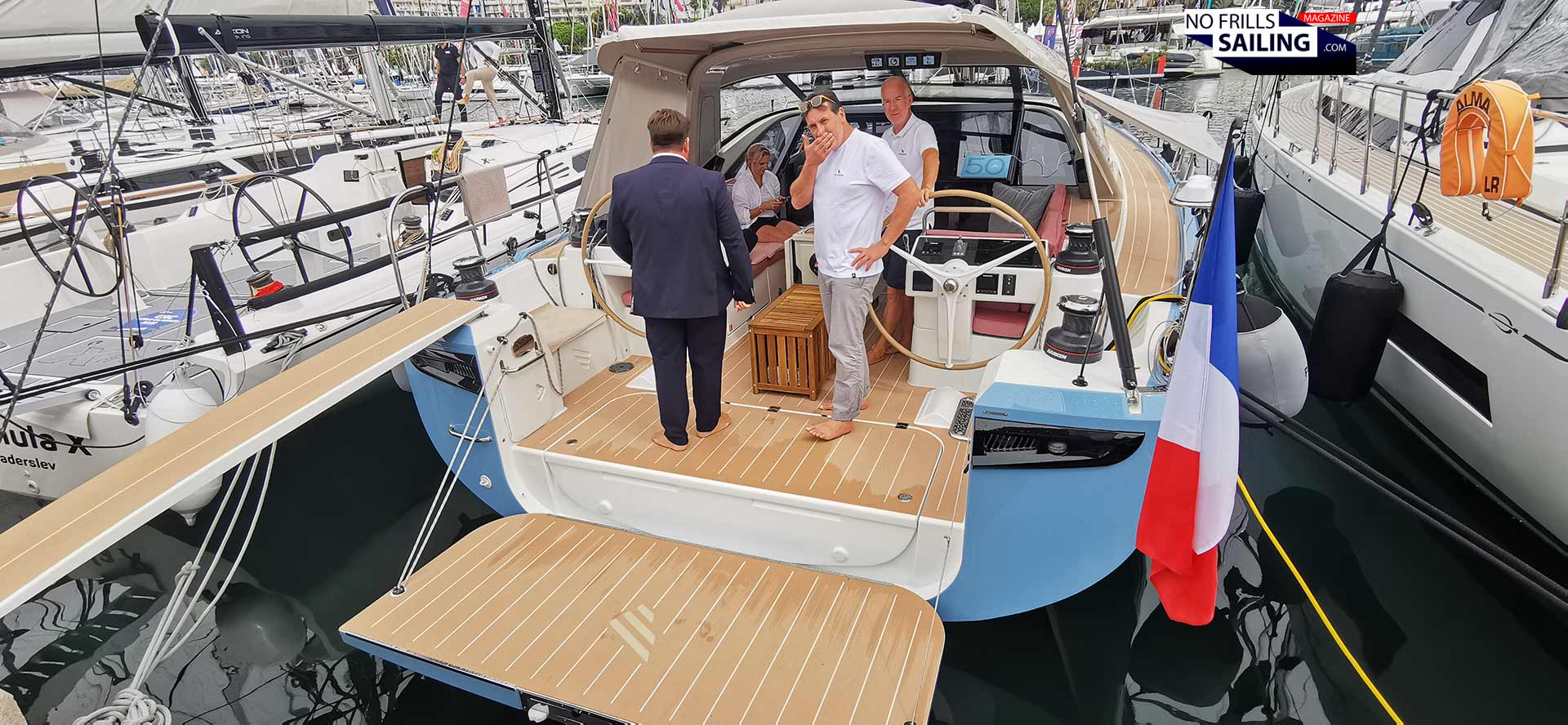
Unfortunately the day when I found time to pay a visit to the Pegasus 50 was the one and only day of the show when there was no sunshine. Instead, a rain shower had just passed and as it seemed the crew didn´t had time to clear up the boat from last night´s party. As I was working during the normal opening hours, I only have time to visit boats before or after the public opening hours. So, excuse the not-so-sunny pictures and the fact that on many photos there are people. But hey, that´s life, right? Now, let´s get aboard and our walkthrough started …
A yacht proposal for the performance-luxury segment
I think it is suffice to say that the underlying idea and reason to come up with the Pegasus 50 was the proposal of a quick, good performing and luxurious cruising yacht with passage-making qualities and a certain amount of luxury. Many aspects of this yacht – not the appearance, but concept-wise – kind of strongly reminded me of an Amel, which honestly isn´t the worst boat you can be compared to.
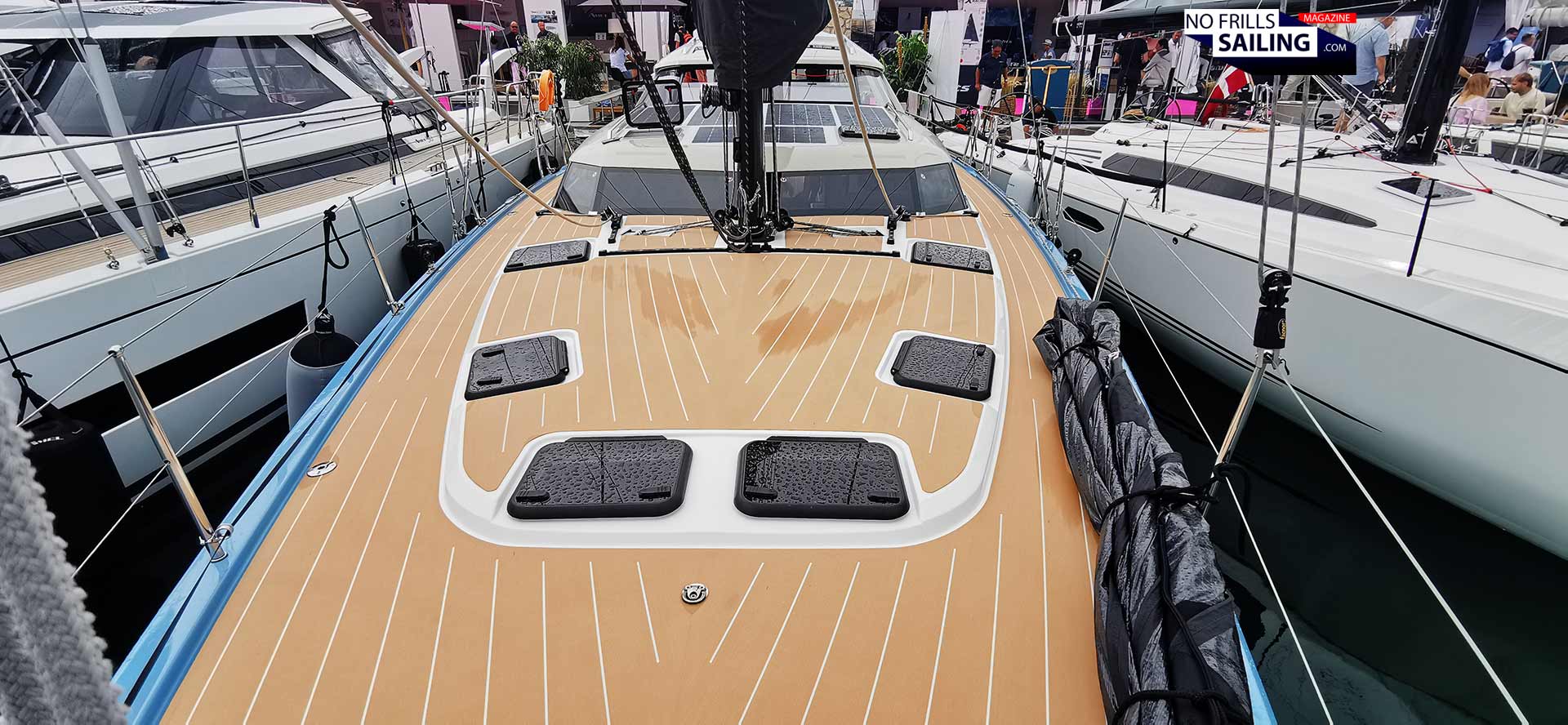
First of all everything about the Pegasus 50 is made and built to last. There is no flimsy sprayhood, no rickety bimini. The deck is made from synthetic material just so to say: Why bothering real wood? We use material that will last even after years and years of UV-bombardment and will still look fresh and nice as if it was launching day. I´ve already mentioned the hard dodger and T-top: Another sign for the true designation of a Pegasus 50.

Again, the design and the lines Marko and Miha came up with are very beautiful. Normally any sprayhood or hard dodger kind of destroys a boat´s line. This can go as far as destroying the complete impression an otherwise beautiful boat makes. Of course I understand that a bimini and more over a sprayhood are very important parts of a boat that is sailed in nice, sunny weather, (or likewise, in shitty weather) but few boats look nice with those. Maybe that´s due to the fact that many boats are initially designed without a T-top or bimini and receive them afterwards. That´s worth an own article, I guess …
Sailing-wise …
Of course I couldn´t take the Pegasus 50 out to the sea and sail her, so we have to look at the bare numbers. With only 11.7 tons she is surprisingly light for a fully equipped cruising yacht. As a comparison, Oyster´s 495 comes in at 21 tons, an Amel 50 will weigh in between 19 and 22 tons. So that´s pretty good news for everyone who is seeking a light boat and best prerequisite for quick sailing and a good performance.

The helm position behind the wheels and winch layout for the running rigging aboard the Pegasus 50 is pretty conservative. Double steering, four winches all within reach of the helmsman. All lines of the running rigging are diverted aft into the cockpit. Working winches are places right next to the helm, light wind sails winches for Code 0 or Gennakers a bit to the aft on the coamings. Working this boat´s lines will be a no-brainer as she is also fully single handed sailing-capable. I like it.

Sails-wise the Pegasus 50 boasts the fully stack of sails if you like: Self tacking Jib, overlapping Genoa and mainsail in combination with your set of light wind sails. In this, her standing rigging may be ordered to fit your needs as a skipper. There are boats with a cutter rigging, you may have the Jib stay flying. Just as you please. As for the mast, it´s fully made with carbon fibers by Axxon Composites, which is part of the standard equipment as I understand it.
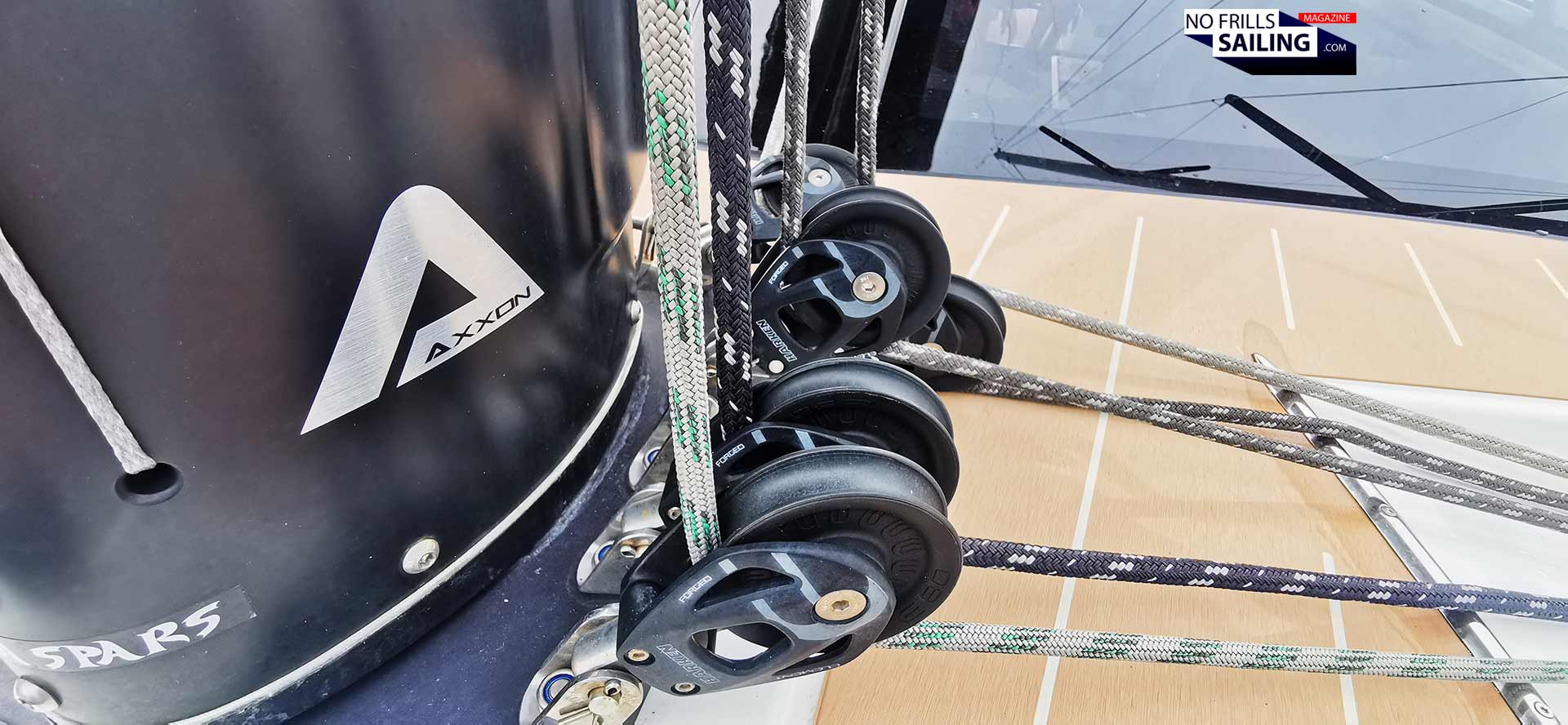
The Pegasus 50 will therefore come up with a total upwind sails area of around 129 square meters (main + Genoa) which is pretty neat. Again, the Amel 50 will bring 126 square meters to the wind, but she is considerably heavier. The Gennaker aboard will cover 188 square meters, which will be an awesome sight if unrolled for sure – and a boost for speed.

Another interesting fact is the ballast and ballast/weight ratio. Pegasus 50 sports a fixed keel. Cast iron fin with a lead bulb. The bulb weighs 3.900 kilogram, which amounts to a total of 33 percent ballast-weight ration in the empty boat. Again, compared to the Amel 50 that’s an interesting comparison. This boat comes up with staggering 5.360 kilogram of ballast, but due to the heavy boat, the ratio is only 24 percent. I don´t want to wander from the subject here, but 24% ballast-ratio seems very … weak chested to me. Anyway, that´s not what I wanted to talk about.
Seamless connection between inside and outside
What makes the Pegasus 50 so interesting is the interior/exterior concept and general layout of the yacht. I wouldn´t call her revolutionary in the sense of the old Finot and Lombard Cigale, but Marko and Miha have invested a lot brains and milked their experience with so many yacht layouts to come up with this, that it is worth a thorough look. For many of my friends and sailing acquaintances, the Pegasus 50 interior concept is a role model, indeed.

Sorry again for the “unconventional” pictures, but as I told you at the beginning of this article, I arrived shortly after the crew got up. Hence, the cockpit was bearing witness to yesterday´s onboard party. Anyways, you can clearly see what´s so new about the Pegasus 50 – the backside of the salon is fully glazed. A wide window that is also entrance into the salon. In classic boats this is gelcoat, also part of the entrance to the aft cabins (of which there are none aboard the Pegasus 50). And as there are no aft cabins, the whole backside could be made of glass.
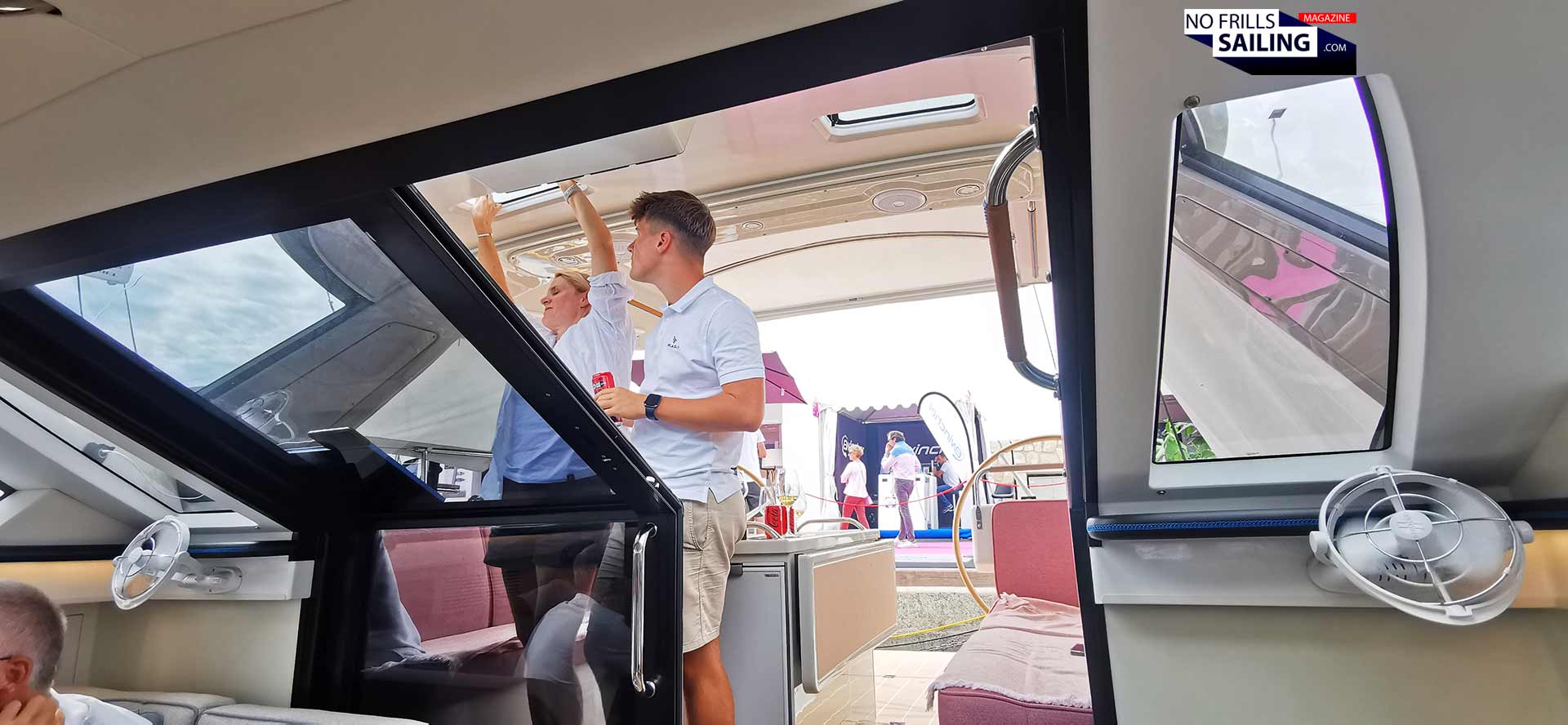
Seen from the inside, this translates to a lot more natural light entering the salon. Also, when inside, you will be able to always clearly see what´s going on in the cockpit. Ground level of the salon is raised so that there are only two steps to get down. This has many advantages. One is the general feeling “down” here, which is not being down in the “basement”. The other is that many auxiliary machinery, tanks and such can be put well underneath the floor and are perfectly reachable for maintenance or possible repairs.
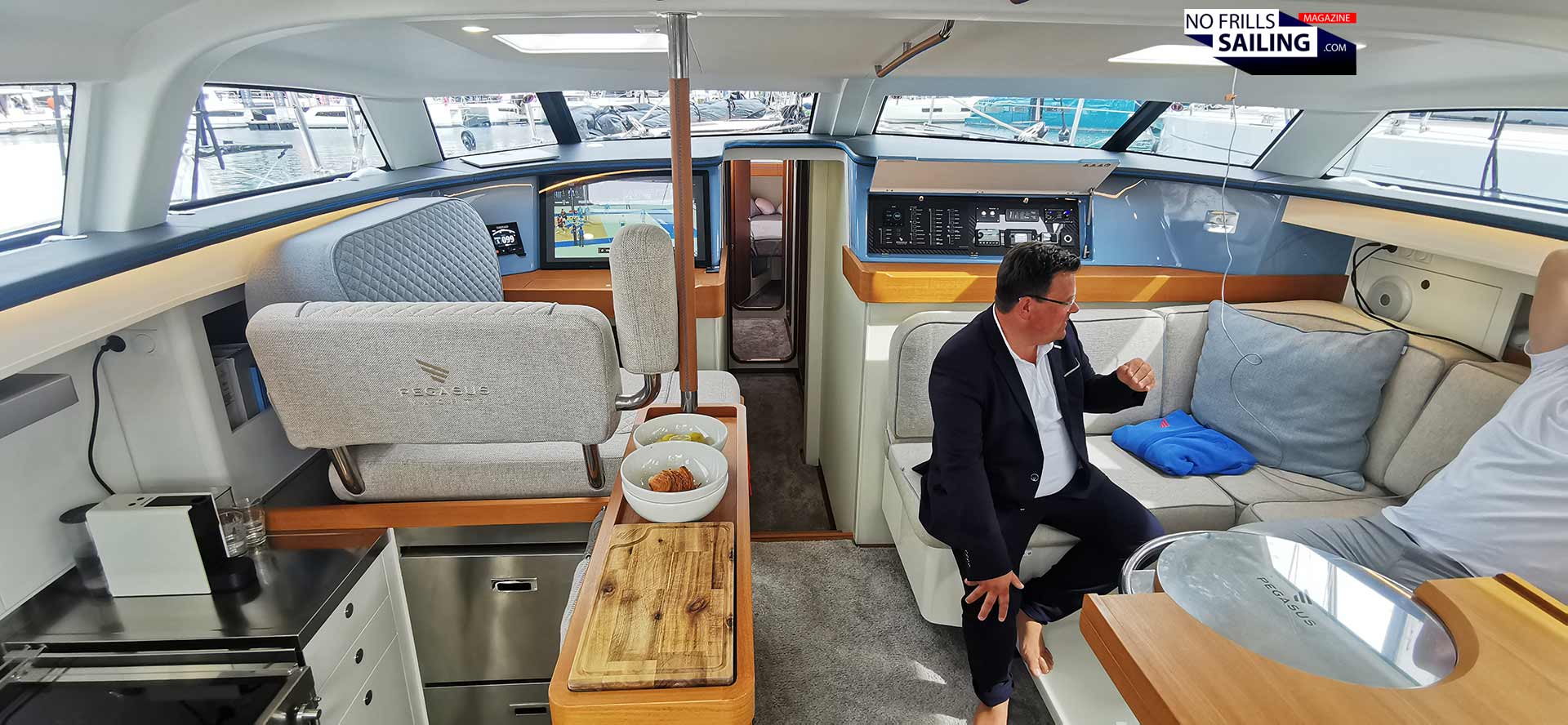
Raised salons are also much nicer when underway – one reason why I love Oyster yachts. Natural light will always have the chance to flood the internals as there is a 360 degree-gallery of panoramic windows all around. The view is breathtaking! Salons in those boats are so much different in their effects and impact on the general feeling aboard. For me, when it comes to long haul travel, having a raised salon yacht is almost a non-negotiable prerequisite to be considered for purchase. Well done, Miha and Marko!
Classic layout, many nuances
Of course, it´s very hard to re-invent the wheel. There are only so many possibilities to arrange the given must-haves inside a boat: Captain´s place with chart table and nav station, galley and of course, the dinette. As for the Pegasus 50, the design decisions made are pretty and this goes especially for the Captains place. To port side a raised, nicely cushioned stool has been put in front of a large chart plotter, VHF and secondary displays. This is the skipper´s seat.

Sitting here will give you a unique view over the foredeck through the large front windows. You may plan your route, check weather and do your logbook entries from here. Vis-à-vis to starboard side – hence reachable also for anyone passing by – is the main switch panel. At first glance I did not like the fact that they had separated the ship´s control switches from the location where the skipper is seated, but maybe that´s due to internal wiring or other constraints, or it was made to make it easier to hit the switches without having to sit down on the skipper´s stool. But that is only a minor detail.
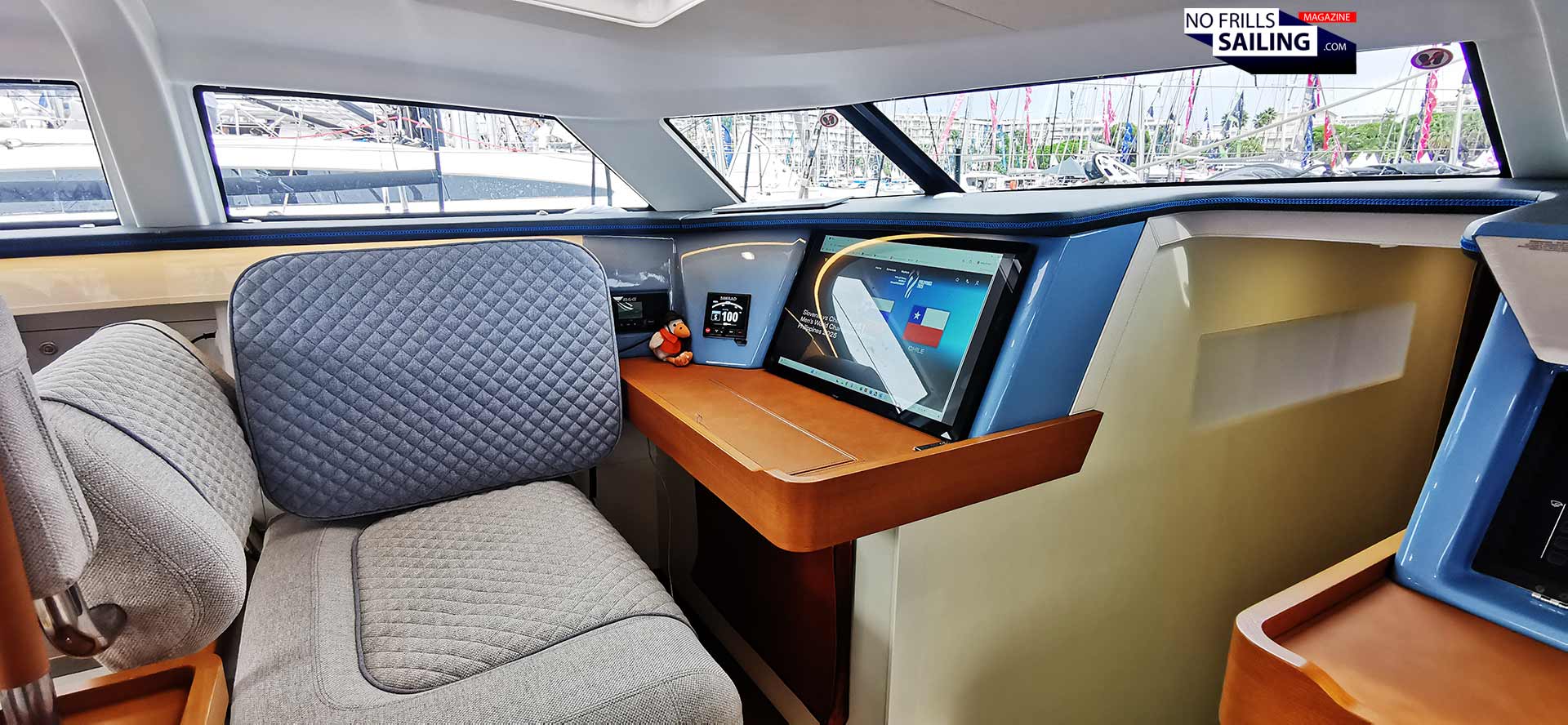
I really loved the seating position and how all is arranged here. It reminded me of forward facing right at the front placed nav stations as seen in the Garcia yachts for example. The downside is, of course, that it makes you traverse the whole salon to reach them. In other boats, the idea is to place these near the entrance so that it will take least time to reach. Both concepts are eligible, it feels fluent and natural aboard the Pegasus 50. But the real deal really is behind this seat: The settee.
A gimbaled settee?
Back in the day when Pegasus Yachts launched the first boat(s), two main facts had been overly discussed in the yachting press. For once it was their approach to deliver a fully electric boat with 15 kW-electric propulsion. This, by the way, is not a thing anymore and the website of the shipyard only offers a classic Diesel-powered sailboat. I have my theory why true offshore-going yachts still aren´t fitted with all-electric drives, but that’s also something for another article. Apart from the electric drive, the second buzz was created by Pegasus´ gimbaled salon.
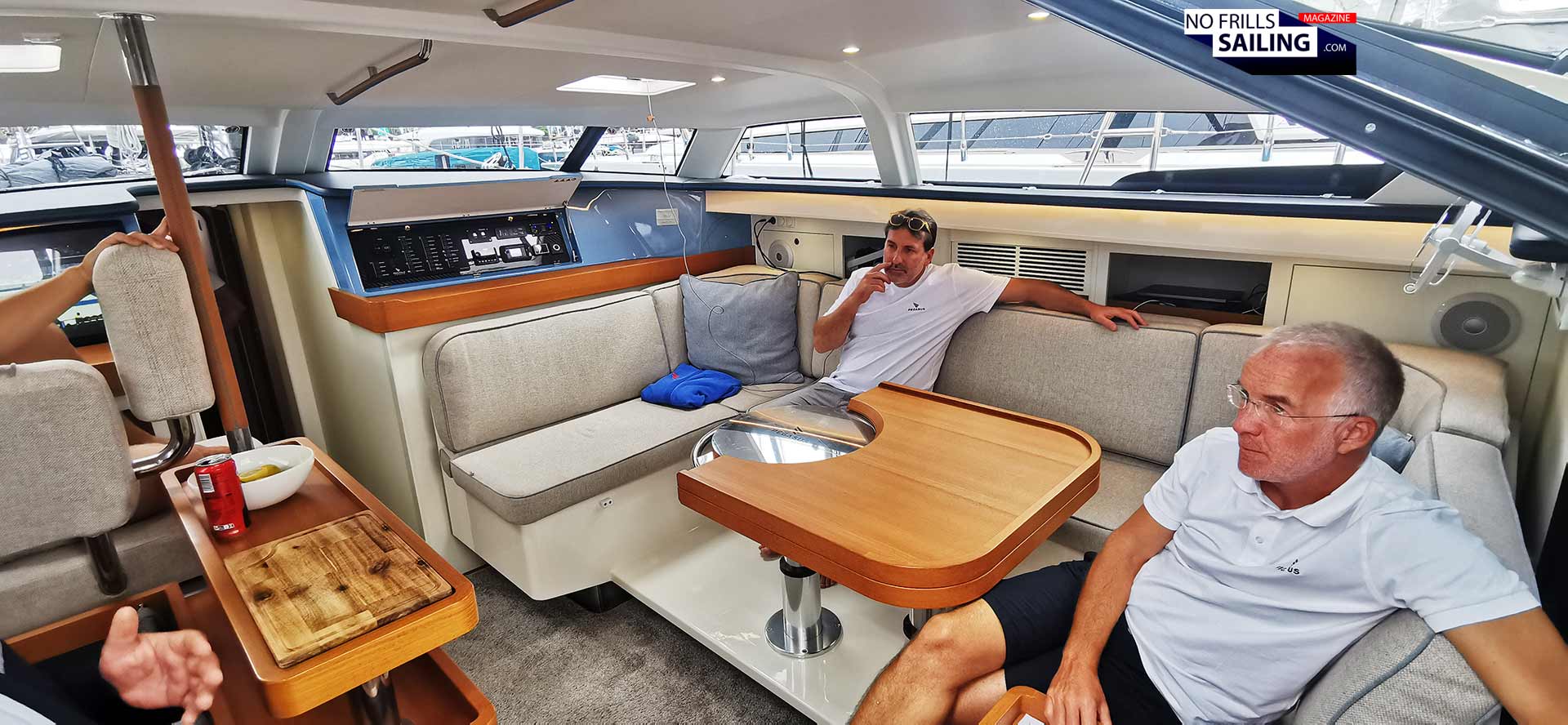
If you look closer onto the above picture you will notice that the settee both guys from the shipyard are sitting on is one single GRP-part. You may also notice the considerable “slot” or gap between the salon´s floor and the settee´s base. Well, it´s because the whole sofa-unit is mounted along the pivoting longitudinal axis of the yacht. If released, it can freely swing (up to a certain degree). The idea is that this way, just as your stove in the galley, the settee will even out in heeled sailing, boosting comforts and minimizing the effects of seasickness. I don´t know if this is a necessary gadget, but it certainly makes people stop and wonder.

Much more than the gimbaled salon I liked the galley, which is placed to portside, another step down from salon ground level. It´s an O-design, almost fully closed. This makes it very safe to work in even in bad weather. Sitting so much deep down in the hull near the keel is also a plus. I liked the heavy quality, stainless steel all along, nice upper-shelf appliances. Clearly a very practical, durable and also modular concept to fit any needs a sailing couple might have.
So many layout options …
But it doesn´t stop at this point. As a 50-footer, which I consider to be a big boat, this yacht is possibly housing a sailing family or luxury charter guests. So what it needs, is cabins. Here, again, Miha and Marko have come up with some pretty interesting solutions as the layout plans show and I was able to experience in Cannes. First of all, after passing through the salon and taking a step down, a long midship corridor opens up in front of me. And I mean long!

A Pegasus 50 can be ordered principally in as many as four different layouts. “Standard”, “Guest”, “Friends” and “New home”. As for all layouts, you will get the owner´s suite with a full size bed (or separated bunks, if he snores too loud) located to starboard side just adjoining the salon bulkhead. This way, as an owner, you will always get to enjoy the full width of the yacht and your bunk is placed right there over the keel: The point of least motion in the yacht. A front cabin with a double V-berth is also available for all layouts, but may also be turned into a huge sails locker. This is what all have in common. Now, you can start to juggle and choose which berth- and head-combination suits your use case best.

In the standard version, vis-à-vis the owner´s suite a single bed may be placed. You can also have a proper guest cabin with Pulman-beds in here. The “friends”-layout proposes four single bunks here. It´s really up to you how you want to combine the possibilities to fit your needs. That said, the boat shown in Cannes did not match the latest (or let´s say, the current) drawings available on the Pegasus-website. Maybe it was a boat built earlier, because some details were strange, some were really “off”.

Owner´s suite wasn´t quite as big as expected, I guess this boat featured the owner´s bed but in the standard configuration. In the drawings, there is much more room now with the longitudinal bulkhead separating cabin from walkway leaving more internal space. Otherwise, bed size was more than suitable and I liked the large hull window, making for natural light inside here. Even though the boat was moored closely to the neighboring yachts, more than enough light could enter.
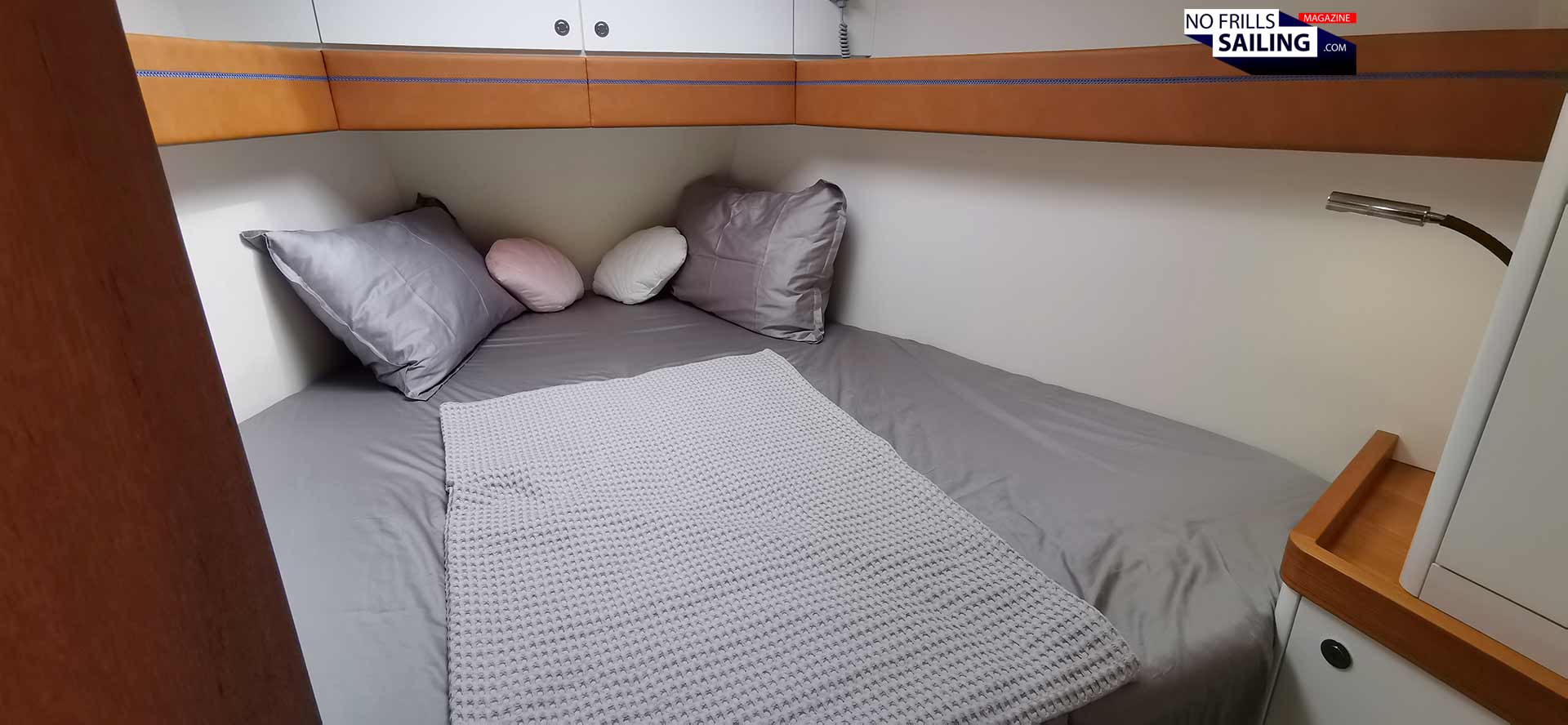
The front cabin was, as usual, the least attractive. It´s a very simple cabin with a V-berth (though very roomy) and some stowage. Bow hull windows would considerable enhance the feeling of comfort in here, but I can also see why they haven´t fitted those. As an oceangoing vessel for long trips, this cabin may be the least occupied, so there´s no need to take the “risk” of cutting holes into the front section of this boat. It got a bit strange when I looked at the bathrooms.
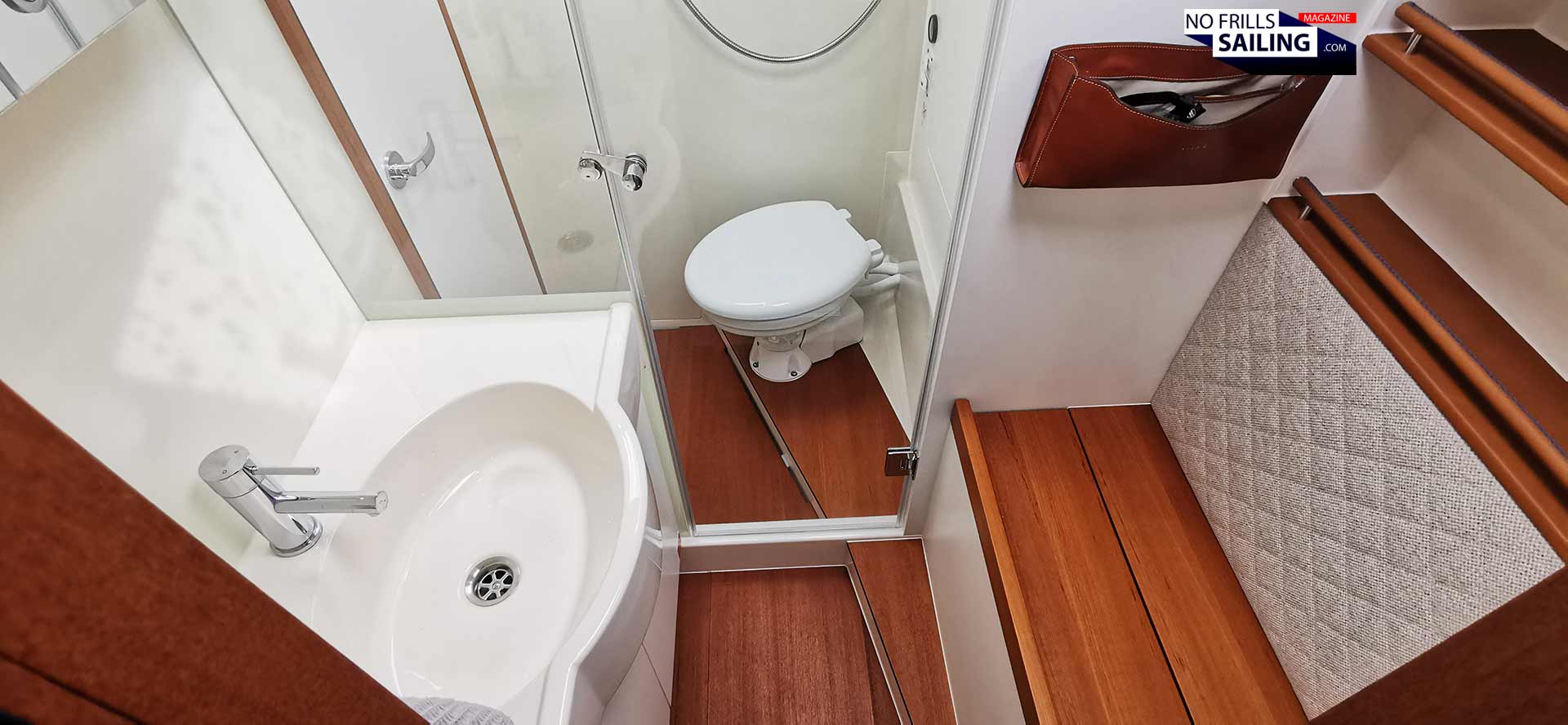
I shall preemptively add that according to the layout plans available on the website, this configuration is no longer available. But it´s interesting to show, because it is also a testament of how designs might look good on paper and turn out being impractical – and how shipyards learn and change. So, this head was nice and roomy, offering all amenities you can ask for. Even my beloved gratings, although in a very simple fashion, were part of the design. But there was something off … look closely.

The guys tried something I have seen (and despised) in the bathroom of the brand new Excess 13 sailing catamaran as well. Two entry doors from opposite sides. What may sound (and look) nice on paper, is a practical night mare. Apart from the fact that you´d have to lock the opposite door and not forget to unlock after using the bathroom every time, it´s very impractical. Look at the picture above: The door cannot even be opened fully as the WC bowl is in its way. I am glad Pegasus does not offer this version anymore.
Nice details and a proof of craftsmanship
But the Pegasus 50 is not only inspiring on the large scale, she indeed comes up with many details which are worth mentioning. Details which are a testament of the shipyard´s focus on providing a yacht that is not only just beautiful and practical, but also nicely crafted and made to last. In comparison to your ordinary series production cruising yacht, it´s nice to discover these little gimmicks here and there.

For example, the padding of many vertical and horizontal panels has been done very elaborately. There´s a nice cross-stitching for the leather parts, which reminds of high class sportscars. This decorative colorful stitching is just a tiny detail, but adds so much to the overall feel of the boat. I don´t know if you have seen it in the pictures of the bathrooms above, but they´ve fitted nice garment-paddings to the heads and cabins as well. I guess you can choose from various materials and colors so that your Pegasus 50 – just like her hull color – will become much more your individual yacht.
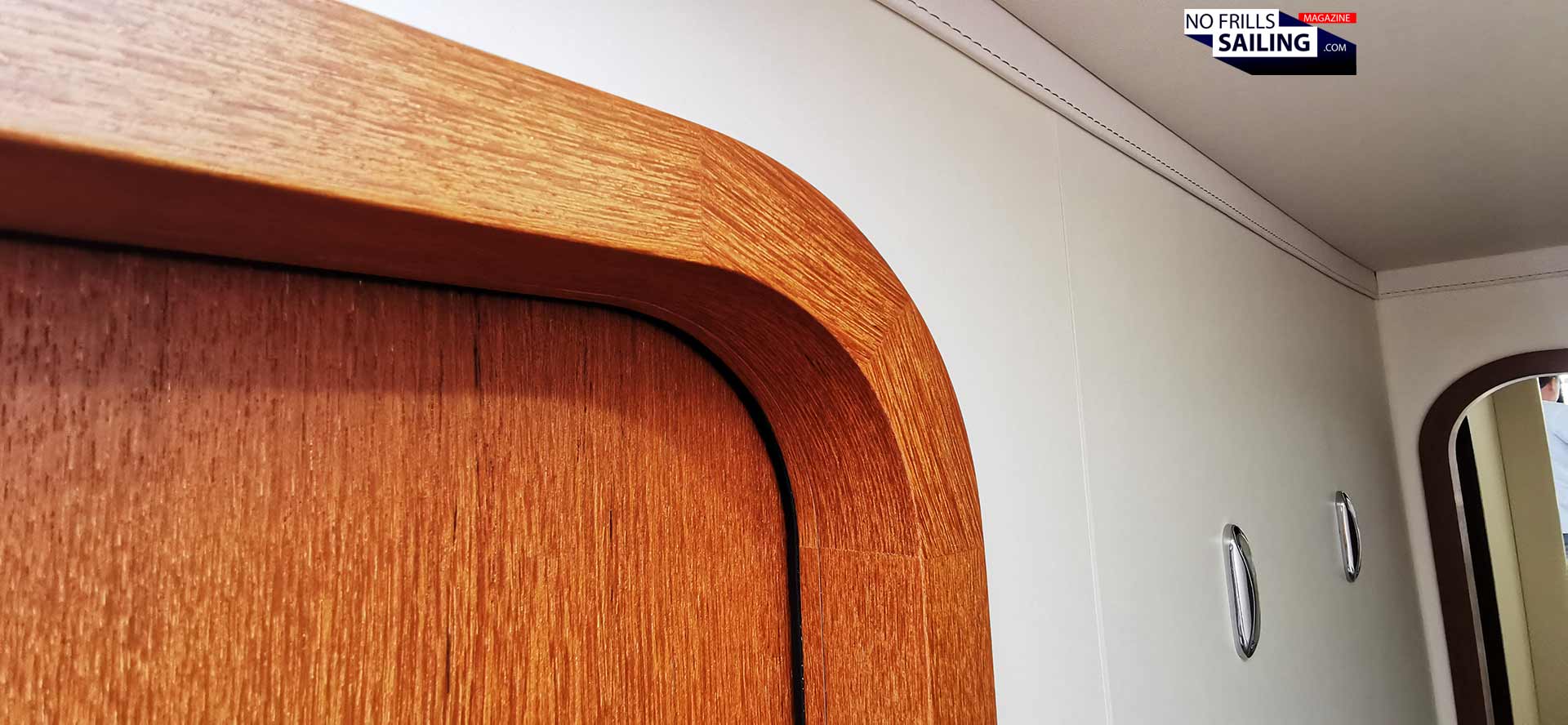
All but praise I have for the joinery and woodworks aboard the Pegasus 50. Were possible, the shipyard utilized massive wooden parts – for the door frames for example – which adds a “heavy” feel to the quality. Fittings, hinges and metal parts are take from the upper shelves as well. There´s nothing more frustrating for owners to see their joinery deteriorate (quickly) with edge bandings coming off or hinges breaking!
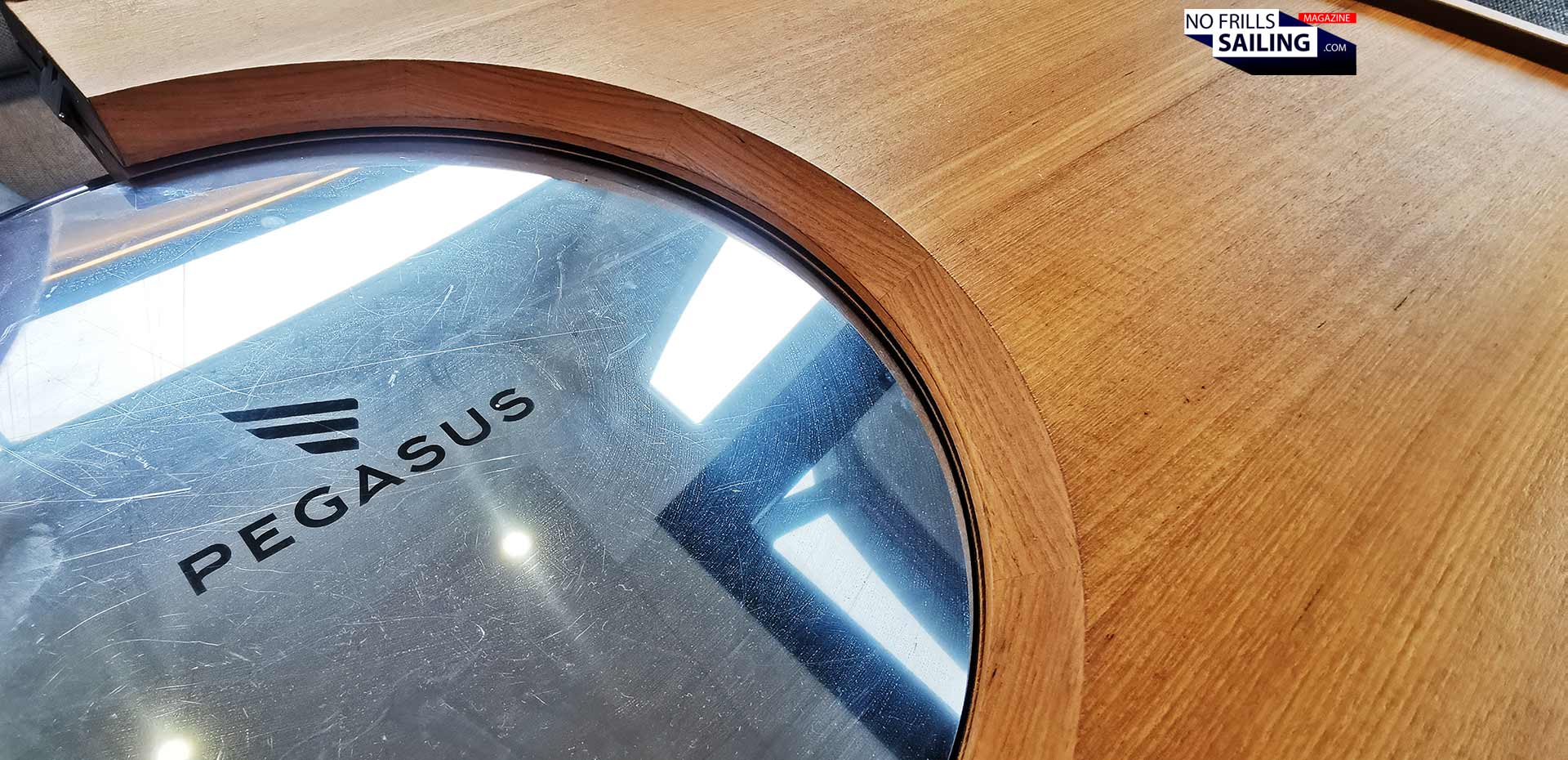
Lastly I can say that the overall building quality in the boat I´ve seen is very high. If it is true and the showcased boat is a bit “older” and not the latest version, it´s even more interesting to see how it all holds up against the backdrop of offshore usage by the owners. This all conveys a full picture of quality and sense for details. I can now fully understand why there was so much fuzz about this yacht when she was launched – the more I don´t understand why there aren´t sailing many more of those.
Is this the ultimate 50-feet cruising yacht?
Yeah, well, that´s the question, right? I am convinced that there is no ultimate or perfect yacht. At least not for everyone. Any use-case, any individual nuance, every skipper, every guest and co-owner is different. And so is the utilization of every boat. For occasional sailors seeking the fun and joy of a short, maybe 2- 3-week long coastal cruise, one of the series production boat might fit perfectly well. For owners seeking a long haul trip, maybe a circumnavigation that takes three or four years, Pegasus 50 is the perfect boat.

I personally liked what I´ve seen very much. I would have made different color choices for sure and also changed the interior layout (I would prefer the “New Home”-concept of Pegasus), but she definitely should be on your shortlist of boats to look at if you plan a big offshore sailing project. She is quick, easy to handle and offers a perfect blend of seaworthiness, practicality underway and a load full of comfort. 50 feet is a big boat, for sure, but she also feels kind of compact and perfectly controllable.

The raised salon in combination with the “all cabins forward”-layout makes for a yacht that is surprisingly “even” in terms of stairs, ups and downs. I can vividly remember the good old days of the Beneteau Sense, which tried to bring this concept to a broader customer base. Many Sense-boats are still around, beloved (and hated) by their owners. The Pegasus 50 manages to combine this “one deck”-approach with clear offshore capabilities. Nice!

As Miha tells me just as I am leaving the boat, the commercial success of the 50 has enabled the guys to invest in the concept and building of an even larger Pegasus. A 67 is in the making and first renderings look promising. There is so much more to tell, for example the interesting price policy of Pegasus, which has almost everything you need to sail away (including commissioning) included in the base price, but that´s something for a follow up. Maybe the next article shows the 67 in the shipyard or a 50 under sails? I´ll try my best. Nice boat, though – another shoutout to Slovenia, the no-so-secret-anymore focus point of sailing in Europe.
More articles which might be interesting:
“Massively exciting!” – talking to Andraz Mihelin on the First 36
